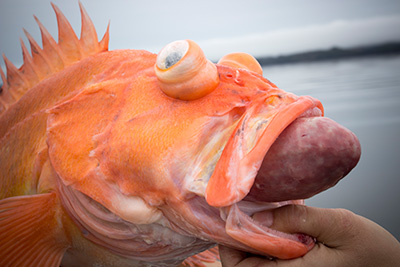Rockfish Conservation
Statewide Rockfish Initiative
Fishery Concerns and Solutions. Rockfish caught in deep water often sustain injuries — referred to as barotrauma — caused by rapid decompression and expansion of gases in the swim bladder. Fish that are released with inflated swim bladders cannot resubmerge and will die. Because of high release mortality,intentional catch-and-release fishing is greatly discouraged, particularly in depths of 60 feet or greater. Alaska anglers can best prevent wasteful rockfish mortality by avoiding waters where unwanted catches are likely. When rockfish are caught incidentally despite avoidance efforts, proper deepwater release techniques can reduce mortality. A recent ADF&G study found that survival of yelloweye released at depth was far higher (98 percent) than survival of fish released at the surface (22 percent).

Anglers can help conserve Alaska’s valuable rockfish stocks by following some commonsense guidelines and employing deepwater release techniques:
Conservation Tool No. 1: Prevention
- Avoid catching unwanted rockfish. When targeting other species, such as halibut or lingcod, rockfish bycatch can be greatly reduced by keeping jigs and bait 10-15 feet off the bottom. This has little or no effect on halibut and lingcod catch rates. Also, avoid fishing in areas with structure attractive to rockfish, such as boulders, ridges, and pinnacles. Move to a different area if you are catching rockfish unintentionally.
- Target other species first: To harvest rockfish as part of a mixed bag, target other species first. This will allow you to retain any incidental rockfish caught as part of your limit, and minimize the number of rockfish released.
- Avoid excessive rockfish harvests: Rockfish have a freezer life of about four months, so harvest only what you are likely to eat in the near future.
- Use release-friendly tackle: When fishing with bait, use a single circle hook. Circle hooks are less likely to cause injury by being deeply swallowed, increasing the chances of survival for released fish.
Conservation Tool No. 2: Deepwater Release
YouTube video of a Deep Water Release mechanisms
Although rockfish caught in deep water suffer injuries due to decompression, survival can be improved substantially by releasing rockfish at the depth of capture. Pelagic rockfish caught in less than 60 feet of water are usually able to submerge on their own. If the fish appears to be inflated or otherwise unable to swim, use a deepwater release device to return the fish to the depth of capture.
A variety of deepwater release devices, or recompression tools, are available commercially.
Anglers can also make their own deepwater release devices out of simple leadhead jigs.

